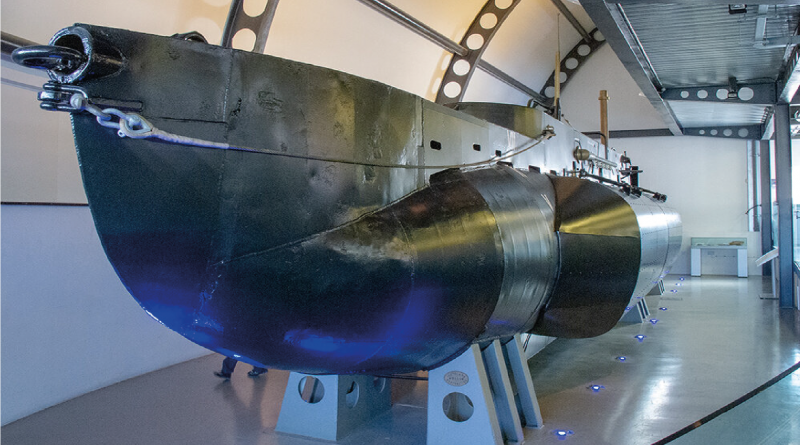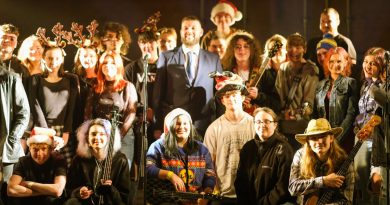COPP marks 80th anniversary of risky D-Day mission
THIS WEEK marks eighty years since two personnel from the Combined Operations Pilotage Parties (COPP) left Gosport and travelled on a second top secret mission to France, where alert German guards may have scuppered early Allied plans for the D-Day invasion five months later.
Major Logan Scott-Bowden and Sergeant Bruce Ogden started their journey on January 17th from HMS Dolphin; this trip aimed at surveying beach conditions in preparation for landing craft alongside the defences already in place. They were joined by three colleagues using a 52-foot long X-craft designed to carry just four men, with the maximum headroom being just under 6 feet in height.
And on the first night ashore at Les Moulins (St Laurent) part of the American Omaha beaches, two Nazi guards shone their torches at the two shadowy figures lying prone on the beach a couple of hundred of yards away. Major Logan Scott-Bowden and Sgt Bruce Ogden Smith lay deadly still as the beams of light fixed on them, hoping that their sand coloured swimsuits would make them look like two sleeping seals.
Half a mile out to sea, their commanding officer Lieutenant Commander Nigel Willmott was standing on the casing of the miniature submarine that had released them safely to swim ashore an hour earlier. The commanding officer of COP feared the game was up and his men could be captured before they could gather vital intelligence for Operation Postage Able.
The Allies hopes of making the Germans believe the invasion would come at Calais were hanging in the balance when the two Nazi guards suddenly swung their torches away. But thankfully they decided not to make their way through the heavily wired beach to investigate further.
The two commandos – who had already visited Gold Beach on New Year’s Eve a couple of weeks earlier without being detected –managed to slither back into the shallows and make their way further along the beach to carry out their clandestine reconnaissance.
Scott-Bowden – talking about his memoir of his COPP missions written on the 50th anniversary in 1994 – said: “I have often wondered what he thought he had seen, and whether he reported it? “We then swam well to the east and tried again. This time there was no trouble.”
The pair were able to confirm the sand was strong enough to bear the weight of tanks and heavy artillery after using augers to take samples down to 18 inches. The soldiers also recorded data about the beach gradient and sea depth, using an underwater writing tablet, a sounding lead and a specially adapted fishing reel, which was used to mark out distances with beads on the line. They then made the 600-yard swim to the awaiting X-23 and this part of their mission was complete despite the major scare.
The following night (January 19) they swam ashore at Vierville-sur-Mer just as an RAF bombing raid to the east at Caen was laid on to distract the Germans. To their horror the flashes from the explosions lit up the X-craft as she lay up well out to sea against the dark, moonless sky. They spent another four hours ashore before swimming 400-500 yards to their recovery position.
During the day, two Major and the CO had spent several hours scanning the shorelines of three beaches through the sub’s periscope. They were able to observe hundreds of men working on reinforcing the gun emplacements lining the paths leading up the slopes to the ridge above Omaha.
Submerged for up to 11 hours meant the air inside X-20 was foul; the atmosphere being heavy with carbon dioxide and diesel fumes. And the toilet could only be flushed when they were well out to sea at night; when they also charged the batteries using the diesel engine (identical to those in a London bus).
With just a few hours of sleep after spending the early hours writing up their reports, the men were feeling the effects of their exhausting mission. They didn’t stop immediately though and observed Germans firing in the direction of their tiny periscope; prompting more fears they may have been spotted.
With the weather deteriorating and the required information nearly collected, Willmott ordered Lieutenant Hudspeth to set a course for Portsmouth inside of risking one more night’s reconnaissance. The swimmers could die from exhaustion or even worse fall into enemy hands.
They arrived back at HMS Dolphin at approximately 6:15pm on January 21st after being towed halfway home by a trawler, on January 21st at 6.15pm. Admirals from Fort Blockhouse lined up to greet the COPPists and submariners upon arrival on the pier; the only negative being the foul fumes blowing downwind as the rear hatch was opened.
Scott-Bowden was whisked to the Combined Operations HQ in Whitehall for a meeting with top military chiefs including General Omar Bradley. This occurred less than 48 hours after their arrival at Blockhouse and was held in secret.
The American General, who commanded the US Army heading to France, quizzed him at length about the tracks leading off the beach and whether they were wide enough for his Sherman tanks to climb up.
The English Major told his US superior: “Sir I hope you don’t mind my saying it, but this beach is a very formidable proposition.” Major Bradley placed his hand on his shoulder and looked him straight in the eye before replying: “I know my boy, I know.”
The General agreed that the two commandos should act as pilots in the landing craft taking the US troops and tanks ashore. But many floundered after being released in too deep water while many of those that Scott Bowden took right in were knocked out by the very machine gun posts they had seen under construction.
Some 2,400 Americans died on the beach on that June day; while X-20 and X-23 guided the British and Canadian forces ashore on Sword and Juno beaches, shining beacon lights out to sea from before dawn.
Scott-Bowden received the DSO and Military Cross for his two trips to Normandy; the first being on New Years Eve of 1943. He passed away in 2014 after a very long and distinguished post-war Army career; where he focused on the countries of Northern Ireland and India.
Ogden Smith received the Military Medal for Operation KJH on December 31, 1943, and the Distinguished Service Medal for Operation Postage Able. He died in 1986 and his medals were brought by Lord Ashcroft for more than £35,000 at auction in 2006.
Images of Scott-Bowden and Odgen Smith can be seen by clicking their names in this paragraph; whilst photographs can further be seen on www.coppsurvey.uk as published by Rob Crane.
PICTURED ABOVE: The X-24, which is identical to the two that completed this dangerous operation exactly eighty years ago between 17th-21st January, gaining crucial information that helped to prepare for D-Day that June. This can be seen on display at Gosport’s Royal Navy Submarine Museum at Haslar.



